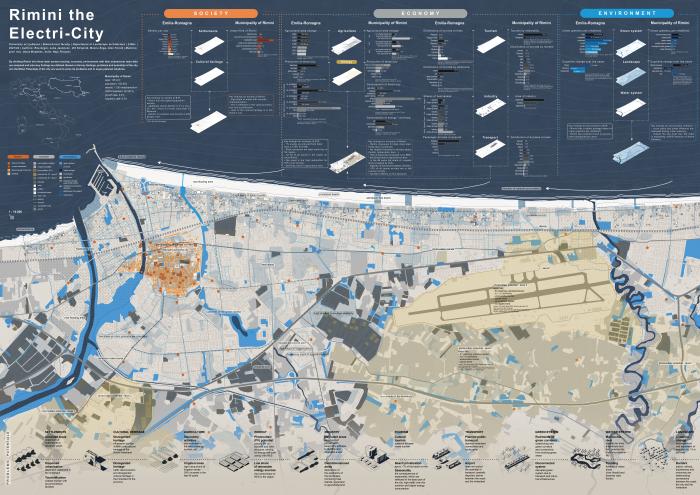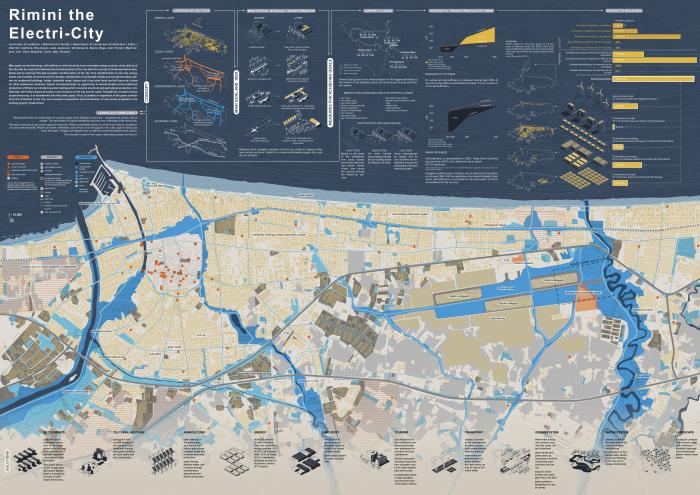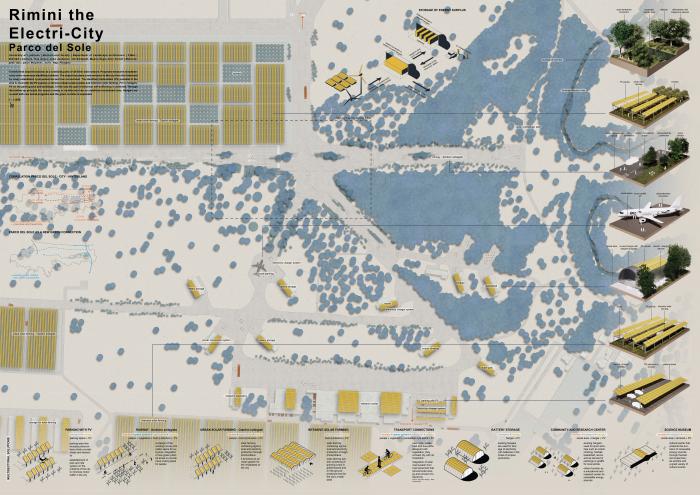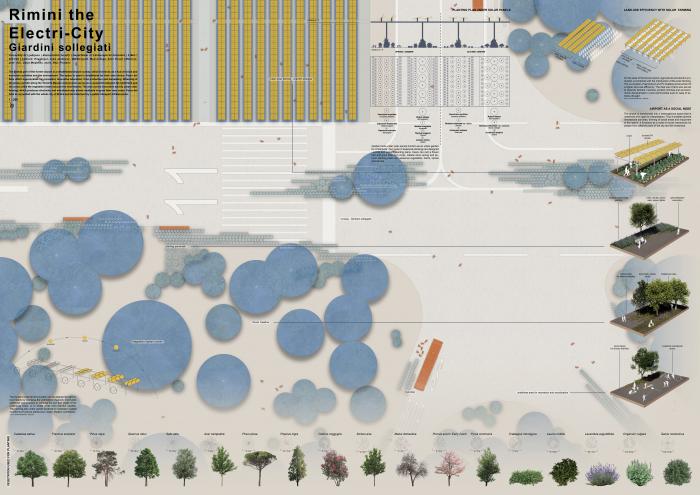We resolve the identified conflicts in Rimini with multi-sectoral solutions in three main sectors - society, economy and environment, which will transform Rimini into a integrated system. Leading factor in the transformation of Rimini are energy-based measures that achieve the goal of self-sufficiency in renewable energy sources. Rimini’s energetic advancement is also accompanied by the creation of public space through landscape democracy principles, resulting with social and spatial inclusion.
Rimini is one of the most attractive coastal cities in Italy, visited by millions of tourists every year. This fact is also reflected in its historic development, city characteristics as well as in different conflicts between uses. Recognized conflicts are addressed with multi-sectoral solutions of three main sectors (society, economy and environment), which will transform Rimini into a holistic and connected system. This system is being realized in newly established green corridors, formation of public spaces, transport and social connections coast – city – hinterland. Leading factor in transforming Rimini into the unified system are energy-based measures. They realize the goal of self-sufficiency with renewable energy sources. Photovoltaic system is being implemented on residential buildings, hotels, industrial areas and the airport, while wind farms are being built on the sea. These steps serve as a base for other subsectors solutions and thus energetic transformation of the city is not only energetic but also comprehensive. The airport closing functions as a combining area of all three main sectors and as an opportunity to realize a set of goals by introducing solar farming which connects electrical and agricultural production, expansion of green corridors as well as shaping of the public space through the process of landscape democracy. It also becomes a new entrance to the city and its coast from the hinterland by establishing additional cycle-pedestrian and bus connections. Through the bottom-up principle the airport runway is being transformed into a public area that is open to all inhabitants for interpretation.
Please highlight how the concept/idea can be exemplary in this context
The idea is based on the creation of an energy system from renewable energy sources with which the city becomes self-sufficient and independent of energy imports. Electricity is produced only from renewable energy sources which are sustainable and have fewer negative impacts on the environment than the use of fossil fuels. As a result, the use of fossil fuels, which have a negative impact on people and the environment through emissions, is reduced. The new model for electricity production by using solar and wind energy follows many sustainable development goals that are affordable and clean energy, economic growth, sustainable cities and communities, responsible consumption and production, climate action and partnerships for the goal. It also follows the principles of the circular economy, as the cessation of fossil fuels reduces environmental pollution, ensures energy circulation through the use of renewable energy sources and enables regeneration of nature by making minimal environmental interventions, as new infrastructure would be installed on existing facilities or degraded areas. A large part of the idea is the involvement of residents in the project, as the use of renewable energy sources ensures affordable energy, improves the quality of the living environment and consequently the quality of life itself. The newly designed energy system is a combination of a sustainable way of obtaining electricity, social inclusion of the inhabitants and improvement of the quality of space and life in the city.
Please highlight how the concept/idea can be exemplary in this context
In terms of aesthetics and quality, the rehabilitated central part of the former airport is undoubtedly the most outstanding. Newly transformed space is open to inhabitants for their interpretation and own choice of use. Area doesn't have a specific programme and thus allows free and democratic use of space for all. Parco del Sole offers opportunities for recreation, innovative education, food production and socializing. Widening of the green corridor along the Torrente Marano watercourse serves as a connection between the hinterland and the coast, while the vegetation mass reduces the heat islands and their impact. The area covers innovative activity urban solar farming, which produces electricity and simultaneously allows residents to grow their own crops. Parco del Sole is connected with the whole city of Rimini and its hinterland by a public transport infrastructure. It enables diverse activities from recreation, enjoyment in nature, cultural and touristical visiting to forming of social and community areas etc. Ex-airport area functions as a node of social interactions for people from different parts of the city and the hinterland.
Please highlight how the concept/idea can be exemplary in this context
Project area is transformed on many levels and sectors or subsectors. Therefore many different spatial problems were recognized, but solutions for those were not met individually. They were multi-layered and complex, yet simple. Numerous innovations did mix with each other and created single solution for great number of problems, or even many solutions for one problem. Hence the energetic transformation of Rimini did not solve only energetic problems and introduce new renewable energy sources, but did also address problem of irrigated farmlands, heat islands, transportation etc. Not to forget that participation process was also used. For example, issues of low share of renewable energy sources, non-irrigated farmlands, energy as well as food dependency and high share of irrational use of space were addressed with solar farming on closed airport with the process of landscape-democracy. Our innovative way of problem solving saves area with multi-layered solutions and adaptive re-use principle.
Airport closing becomes an opportunity to almost double current electrical production of Rimini by introducing solar farming which connects electrical and agricultural production. Additionally, the former airport becomes a new entrance to the city and its coast. Through the concept of landscape democracy, it is transformed into the public space. Thus, it enables an expansion of the green corridor from the hinterland to the city, new transport connections and introduction of new social programs in the existing airport infrastructure. The airport is transformed into a heterogeneous space that is open for interpretation through the bottom-up principle.
On the coast of Rimini, deprivatized beach is transformed into a public space which belongs to everyone – residents and tourists, free of charge. The sand beach is without predefined solutions and is belongs to the community.
Please highlight how this approach can be exemplary
By dividing Rimini into three main sectors (society, economy, environment with their subsectors) we can analyse main data and defined main key findings, which allow our plan to embrace goals such as environmental sustainability, increase of landscape quality, quality of experience and social inclusion of residentials and tourists. Main goals are the following: self-sufficiency with electricity from renewable energy sources, close link-up of the city with its coast and hinterland and transformation of the city with the concept of landscape democracy. Goals were achieved through energetic transformation of the city. The transformation is not only energy based, the energy system also serves as a combining link for a sustainable way of obtaining electricity, social inclusion of the inhabitants and improvement of the quality of space and life in the city. Introduction of renewable energy sources (photovoltaic system on residential buildings, hotels, industrial areas, airport and a sea wind farm) will serve as a base for other subsectors solutions. Airport closing becomes an opportunity to almost double current electrical production of Rimini by introducing solar farming which connects electrical and agricultural production. Additionally, the former airport becomes a new entrance to the city and its coast. Through the concept of landscape democracy, it is transformed into the public space. Thus, it enables an expansion of the green corridor from the hinterland to the city, new transport connections and introduction of new social programs in the existing airport infrastructure.
Concept of landscape democracy and bottom-up principle were used in the transformation of privatized areas into public spaces. Through public participatory process newly gained public spaces are result of co-design. Processes are meant to be used in the short, medium and long term. First step is that the people of Rimini are freely designing new public spaces with their activities, in the short term. In medium term, subareas of activities are almost established and spatial designers are getting involved. Long term brings final design for activities that were defined by the users. To do the first step it is necessary to ensure free access and non-defined design, so that locals can use space freely. Secondly, users begin to create the same space with their activities. Based on the most common uses of space, areas of potential defined uses begin to form. Spatial designers and decision-makers are then there to co-design space and consider people’s needs and desires. Therefore every individual has the equal opportunity to engage and helps to solve spatial problems, such as accessibility and affordability.
On the area of the former airport, agricultural and electric production is combined with the introduction of the solar farming. Garden beds under solar panels function as an urban garden for inhabitants or as agricultural land for farmers. The co-location of agriculture and PV enables achievement of a higher land-use efficiency. The dual use of land also serves to diversify farmers’ incomes, protect incomes and socioeconomic development in rural communities even in case of extreme drought.
The main idea of the concept is to produce electricity from renewable energy sources to achieve electrical self-sufficiency of the city. Energy production is realized by installing solar panels on one third of all roofs of residential buildings, on one third of hotel roofs, on most of industrial buildings, on half of the area of the former airport and by installing wind farms at sea. Currently, the city of Rimini is 40% self-sufficient. It is estimated that electrical self-sufficiency of the city would be achieved as early as 2025, but at the end of year 2050 at least 113 % electrical surplus or 213 % self-sufficiency would be accomplished. To achieve the set goal, it would be necessary to raise the awareness of local people about the importance of using renewable energy sources. The area of the airport functions as a reminder of the importance of renewable energy sources. New science museum, research and education centre serve for educational purposes and new efficient ways for food production are based on solar panels (agro-farming). In addition to electrical self-sufficiency, the project also solves spatial problems related to other sectors. Recognized conflicts are addressed with multi-sectoral solutions of three main sectors (society, economy, and environment), which will transform Rimini into a holistic and connected system. This system is being realized in newly established green corridors, formation of public spaces, transport, and social connections coast – city – hinterland. What they all have in common, however, is that they solve problems related to the well-being and health of the environment and residents of the city.
If the project Rimini the Electri-City was awarded by the New European Bauhaus it would be a confirmation of our further work in the field of regional and local planning and landscape design. We could set guidelines for the development of areas that need better self-sufficiency in the fields of energy and food production, encourage general awareness of community about the use of energy or renewable energy resources and design the space according to the principles of multisectoral solutions which enables achievement of a higher land-use efficiency, landscape democracy, bottom up approach, landscape urbanism and social inclusion.
If the project Rimini the Electri-City (idea for energy self-sufficient city) were awarded by the New European Bauhaus, it would be a confirmation of our further work in the field of regional and local landscape planning and design. We could set guidelines for the development of urban spaces, hinterlands and rural areas that require better self-sufficiency in energy and agricultural sector. As well the project would encourage or regulate spatial planning according to the principles of multisectoral solutions, landscape democracy, bottom-up approach, landscape urbanism and social inclusion. At work, we strive for sustainable and inclusive transformation of degraded, devalued, segregated and gentrified areas. We also take into account new practices and experimenting with new technological innovations that help to protect the environment, prevent climate change and facilitate the lives of local residents. Our example of landscape planning and design in Rimini includes a combination of different economic, environmental and social uses in the area. With which we can provide better usage of the area, make it more diverse and more attractive to visitors. The case of Rimini can be adapted to many of Europe's small and medium-sized cities. At the same time, we are taking an inclusive initiative to educate the local residents and tourist
@Stropnik, 2022
Content licensed to the European Union.



